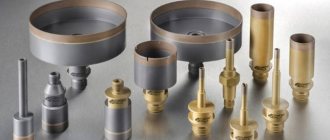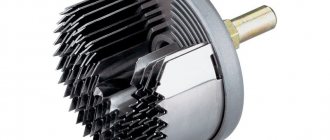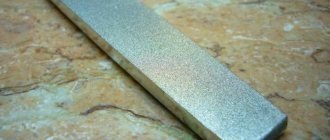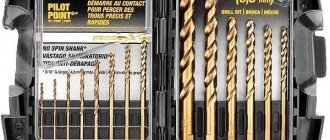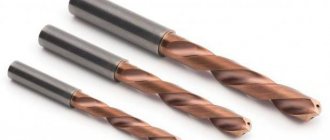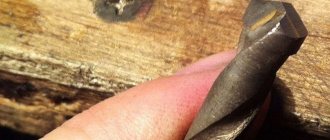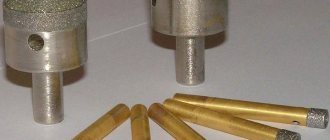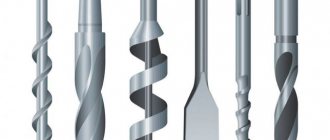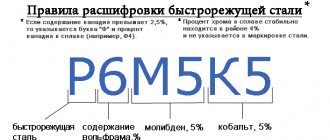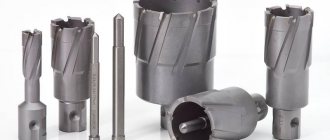Description of annular diamond drills
A conventional drill - flat, screw, gun, produces a hole with the entire surface. Therefore, to form a hole with a large diameter, the diameter of the tool must be the same size. Considering the resistance of a durable material, this drilling method turns out to be very expensive.
- The working part of the annular drill looks different: it is a thin-walled crown, the edge of which is formed by diamond coating or segments.
- The crown body is connected to a shank of the appropriate shape - cylindrical, conical or special. For household devices, the product is produced with a universal shank or with appropriate adapters. However, when drilling a hole with a diameter of more than 80 mm, it is preferable that the shank has the appropriate shape and is attached without bushings.
- The crown body is made of steel grades 20, 30, 36, the extension - shank is made of steel 40, 45 is allowed.
Products with diameters from 20 to 215 mm are produced.
Pros and cons of using core drills
Compared to traditional screw drills, the ring-type tool has significant advantages and disadvantages
| Advantages | Flaws |
| possibility of using a lower power drive for drilling identical diameters | tool cost |
| high quality and low surface roughness inside the holes | difficulty in sharpening, impossibility of sharpening in cases where the cutting part is coated with diamond |
| installation on hand drills, drilling, milling and lathes | |
| simultaneous use in combination with other types of tools | |
| High speed drilling of large holes, increasing productivity | |
| optimal drilling mode at the same speed of movement of the cutting teeth, while at the edge of the twist drill the rotation speed is not the same | |
| low noise level during operation | |
| robust design ensuring safety |
The main disadvantage is the impossibility of obtaining deep blind holes. In addition, they note the higher cost of the tool and the lack of drills with a diameter of less than 12 mm.
Drilling process
Example of work: 3 holes for the lock tongue in a metal profile pipe.
Material processing when using annular drills can be carried out dry or wet. Dry drilling is used in domestic conditions, in the absence of the technical ability to supply cutting fluid and drilling holes with a diameter of up to 25 mm. This processing method is more labor-intensive, requires more time and entails faster wear of the cutting edge.
Specifications
The obvious advantage of a diamond drill is its high strength and durability. Diamond is the standard of hardness, and therefore all materials without exception can be processed with diamond spraying.
Unlike a conventional drill, a crown does not turn the core into chips, but cuts it out. The working surface is much smaller, which saves up to 85% of power.
The rotation speed is limited by the power of the tool and the thermal conductivity of the material being processed.
Based on the method of applying the working layer, there are 2 groups of crowns:
- C1 – a crown with a continuous diamond layer, used for making holes in concrete and reinforced concrete at a specific pressure of up to 5 MPa. The layer itself is a mixture of diamond-bearing technical powders of a certain grade. A mandatory requirement for it: diamonds must be opened.
- C2 – a crown with an intermittent diamond layer, allows a specific pressure of up to 2.5 MPa. Wider diamond-coated segments are fixed to the edge of the crown. The segments themselves can be of two types:
- round - installed on small-diameter drills, used for processing stone, tiles and glass;
- curved rectangular plate , like a solid one - such a tool is used when drilling large-diameter holes and for drilling.
The tool offers two drilling methods – wet and dry. The crowns have different structures.
- Drilling bit for dry drilling - that is, without water supply for cooling. They are made by laser welding, since during dry drilling the temperature reaches more than 40 C. Through holes are formed on the body of the bits, which remove heat and reduce the risk of damage to the tool.
- A drill for the wet method is made by welding; the supply of water during operation reduces the temperature, and, therefore, the load on the bit.
Production technologies
Today, two main methods of manufacturing diamond drills are used:
- sintering, which involves the use of powder metallurgy methods;
- a technology by which diamond coating is applied to the cutting part of the drill using the galvanic method.
Sintering allows the production of cutting tools that are extremely wear resistant. The most significant disadvantage of this technology is that it can only be used to produce large-sized tools, such as, for example, diamond annular drills. This is explained as follows. In order to create a durable product using this technology, it is necessary that the gaps between the diamond grains from which such a product is sintered be small. Then the created material turns out to be more monolithic and, as a result, more durable. In cases where the cutting part of a small drill is made by sintering, such gaps are comparable in size to the size of the diamond grains themselves, which makes the resulting material very unstable to mechanical loads and causes its intensive destruction.
Vacuum sintered diamond bits designed for clamping through adapters
Using sputtering technology, which involves the use of galvanic equipment, predominantly tubular diamond drills are produced, as well as tools with a conical cutting part. Using this technology, it is possible to produce miniature diamond-coated drills, even with complex configurations.
The diamond coating created using this technology is characterized by a single-row arrangement of grains, which is why it has rather low durability. This is especially critical for coatings applied to tool cutting edges. For this reason, a diamond-coated drill, which is produced by the galvanic method, has a short working life, but this disadvantage is compensated by the low cost of such a tool.
Inexpensive galvanized drill bits for dry drilling
Scope of application
- Drilling rocks and rocks, as well as drilling in the ground when laying communications.
- Drilling of concrete and reinforced concrete structures. Despite the high cost, the tool is very cost-effective, as it significantly reduces the time required to complete the work. Drills are produced for both hand tools and construction equipment.
- Drilling tiles and stone – facing slabs are distinguished not only by their hardness, but also by their fragility. Making holes of even medium diameter in them for a socket is not at all easy. A diamond crown cuts out a fragment, tiles and stone do not experience such stress, damage is extremely rare.
- Glass is an even more fragile material, which during normal drilling cracks and crumbles into fragments with sharp edges. The diamond crown, thanks to a very thin cutting line, creates a narrow strip of impact, in fact, it simply cuts through, and the glass remains intact even when large-diameter holes are formed.
Drilling holes with diamond core bits in concrete
Very often there is a need to drill holes in concrete or reinforced concrete (reinforced concrete).
This need may arise for builders when laying electrical installations, plumbing and ventilation pipes, for drilling openings, as well as when installing air conditioners and wiring the Internet. Concrete is a highly durable material and drilling it is often difficult.
In cases where there is a significant amount of work to be done, concrete drilling is performed using diamond drilling. The work is carried out using drilling machines and diamond bits, also called diamond drills. A diamond bit is a metal cylindrical body with a mount for drilling machines on one side and soldered diamond segments on the other side. At factories, in some cases, segments are welded onto diamond crowns using laser welding.
Drilling
A tool with a continuous layer is used when working with finishing: cutting out holes for communications - gas pipes, heating, and socket boxes. In this case, the aesthetics and precision of the hole are extremely important: the diamond cup allows you to form a perfectly round, clean hole in any ceramic tile or finishing stone.
The photo shows the process of drilling a plexiglass plate using a ring drill
Diamond annular drills with a diameter of 20 mm with an intermittent layer are suitable for processing natural stone, brick, concrete, marble, and tiles. When carrying out repair work, before drilling, you need to make sure that there are no hidden communications or frames in the area: a crown will cut through a reinforced concrete structure as easily as a nail in wood.
Drill 20 mm
Crowns with a diameter of 20 mm are available with both a solid and continuous diamond layer. There are two drilling methods:
- Dry - most often used in everyday life, since there is no need for holes of large diameter and depth. The dry method, due to the load on the tool, is more labor-intensive, takes longer, and generates a lot of dust. Therefore, the operator must wear a respirator.
- Wet method - when working, water is supplied under pressure into the inside of the tool and cools both the drill and the material. In addition, water washes away the resulting crumbs and dust.
Wet drilling is faster, more economical, and therefore much more widespread. The dry method is rather a necessary measure in cases where water supply is impossible.
Drills 50 mm
Crowns with a diameter of 50 mm are most often used for drilling technical and optical glasses. Here the accuracy and fineness of the cut is of great importance, but low material consumption is also important.
Recommended rotation speed for diameters from 25 to 50 mm is 1200–2500 rpm.
Cooling is a must. “Dry cutters”, that is, crowns for dry drilling, are highly undesirable.
GOST drills
Diamond core drills are regulated by GOST 24638-85. The standard regulates the geometric parameters of the product and permissible errors, as well as the material of manufacture for the crown body and holder.
GOST contains data on the composition of the diamond-bearing layer and the mass of diamonds. Depending on the type of crown - C1-2, C2-2, C1-3, diamond powders of different brands are used. In category C1-3, the use of grinding and synthetic powders is permissible.
According to GOST, the kit includes:
- diamond drill;
- 2 rings;
- instructions for replacing the ring.
Drills 125 and 160 mm
Diamond drills with a large diameter - more than 100 mm, are primarily used for core sampling. Today, the tool is used in almost all construction and repair work for drilling holes in partitions and ceilings, creating openings, connecting holes in pipelines, drilling difficult-to-cut materials - granite, diabase, and so on.
Drilling is carried out with cooling with water or compressed air.
Features of use
Each type of diamond drill has certain features that must be taken into account when choosing and using such a tool.
Diamond coated crowns
Diamond tools, the cutting part of which is equipped with crowns coated with galvanic coating, are very similar in appearance to conventional core drills. The great advantage of such a tool, in addition to its affordable cost, is also the fact that when using it, little end pressure is exerted on it. Thanks to this, it can be used for drilling at high speeds, which increases the productivity of the process.
Types of diamond bits
Meanwhile, a core or tubular drill, the cutting part of which is coated with diamond, also has a serious drawback: it has a short service life and allows only a few holes to be made efficiently. That is why tools based on a diamond-coated tube are used primarily for drilling tiles.
Drills with cutting elements made of sintered diamond chips
As mentioned above, drills, the cutting part of which is made from diamond chips by sintering, are highly reliable and can be successfully used for a long time. Each of these tools, if all technological recommendations are followed when using them, can drill more than a hundred holes. However, drills in this category also have disadvantages, the most significant of which is that during the processing process the tool is subjected to significant end pressure, which does not make it possible to use high processing speeds. This drawback causes a significant reduction in drilling performance.
Tubular drill bit "Zubr-Professional" with diamonds on vacuum soldering
Cone type diamond drill bits
A diamond tool with a cone-shaped cutting surface simultaneously combines the advantages of diamond drills, which belong to the category of tubular-type tools, and annular drills. As mentioned above, such a tool is very similar in appearance to conventional metal drills, but differs from them in the material of manufacture. Advanced technologies are used to apply a diamond coating to the working surface of such drills, which makes it possible to create a tool that is highly resistant to wear.
The technology used to process the working part of cutting tools of this type makes it possible to create a coating on it in which the number of diamond grains is increased by 2–2.5 times. This technology does not involve conventional galvanic treatment, but the application of a diamond coating using the vacuum diffusion method. When using this method, the gaps between the diamond grains are filled with metal, which ensures the highest durability of the coating being formed.
Advantage
- Diamond drills allow you to process materials of any hardness and strength with equal efficiency.
- High Precision – The diamond edge produces a very fine cut, allowing for extreme precision.
- Reduced energy costs - the crown cuts out the core rather than converting it into chips. As a result, working with a diamond drill will require less time and much less power.
- Drilling of concrete and reinforced concrete structures occurs using a non-impact method, which also reduces energy consumption.
- There is no dead center in , so there is no need for pre-drilling.
- When drilling, less dust is generated, and accordingly, the noise level is also significantly lower.
Benefits of use
It is rational to use a diamond drill for:
Holes made with such a tool do not require additional actions to process and remove unnecessary debris.
- Elimination of additional processing due to dimensional accuracy and removal of excess slag.
- High productivity.
- Performing work in hard-to-reach places.
- Absence of defects in load-bearing walls or ceilings after the work performed.
